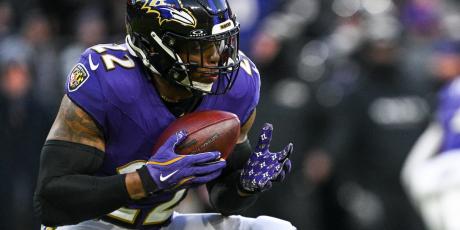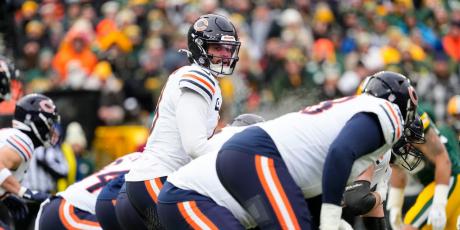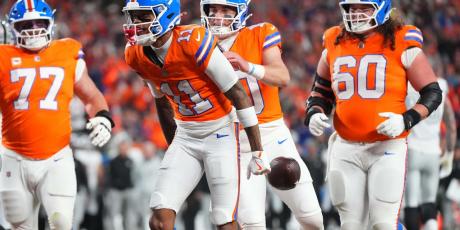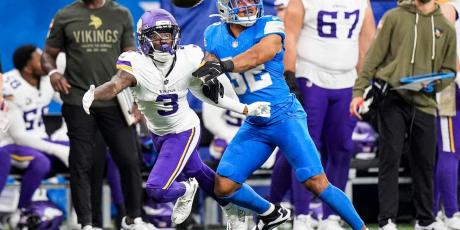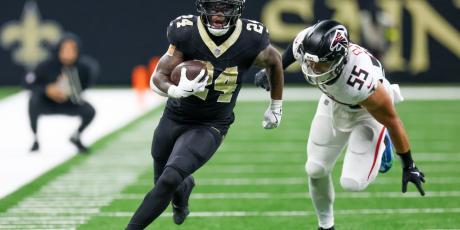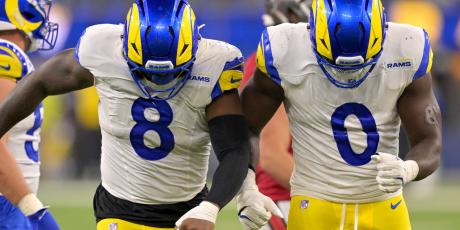Does the Patriots Defense Really Shut Down the Top Option?

Being strong against a team’s strength is a staple of Bill Belichick’s coaching philosophy. Belichick, a three-time coach of the year, works with defensive coordinator Matt Patricia -- who's literally a rocket scientist -- to come up with weekly game plans aimed at shutting down the opponent’s top receiving option. But has the strategy been successful to the point where fantasy owners should be taking it into account? To find out, I looked at how top receiving options fared against the Patriots compared to the rest of the league.
Defining "Top Option"
Identifying a team’s top option is somewhat of a subjective process. Essentially, he's the team's most dangerous receiver. Most teams are smart and target their most dangerous receiver more than their other receivers. But some aren't, and don't. I designated each team’s most highly targeted player (regardless of position) as its top option by default, but did make a few adjustments in cases where I felt the team's target leader wouldn't be considered the top option by Belichick.1, All in all, four of the 64 top options I designated didn't lead their team in targets during the season. All players involved in this study are listed here.
The Struggle Has Been Real Since 2013 for Top Options Against the Patriots
For each game between 2012 (Patricia’s first year as defensive coordinator) and 2015, I compared targets, receptions, yards, touchdowns, and fantasy points for top receiving options when they faced the Patriots to their season average in games when they didn't.
After a shaky first year under Patricia that saw them give up over 25 percent more fantasy points per game to top receiving options, the Patriots rebounded to hold top options below their season averages in every single statistical category from 2013-15.
| Year | Tar/G | Rec/G | Rec Yd/G | Rec TD/G | Std Pt/G | DK Pt/G |
|---|---|---|---|---|---|---|
| 2015 | -12% | -28% | -21% | -33% | -13% | -17% |
| 2014 | -9% | -18% | -15% | -67% | -19% | -15% |
| 2013 | -9% | -15% | -7% | -69% | -7% | -6% |
| 2012 | 19% | 22% | 28% | -60% | 26% | 28% |
The Patriots held opposing top options under their season average in targets 63 percent of the time and under their season average in fantasy points 65 percent of the time from 2013-15 -- a notable feat considering they had different pairs of starting corners each year. They've done an especially outstanding job of keeping top receivers out of the end zone in every year of Patricia's tenure.
We're on to 2016 -- Can the Patriots Continue to Hold the Top Option in Check?
In 2016, the Patriots will return all the core members from their '15 secondary, including cornerbacks Malcolm Butler (who made the Pro Bowl last season) and Logan Ryan, and safeties Devin McCourty and Patrick Chung. Belichick himself once said "to live in the past is to die in the present", but let's for a moment ignore him like he ignores the media and look at the game by game breakdown of how the Patriots fared versus top options in 2015. After that, we're on to next year.
| Week | Player | Tar | Tar % Diff | Rec | Rec % Diff | Rec Yd | Rec Yd % Diff | Rec TD | Rec TD % Diff | Std Pt | Std Pt % Diff | DK Pt | DK Pt % Diff |
|---|---|---|---|---|---|---|---|---|---|---|---|---|---|
| 1 | Antonio Brown | 11 | -9% | 9 | 6% | 133 | 17% | 1 | 20% | 19.3 | 25% | 31.3 | 30% |
| 2 | Sammy Watkins | 8 | 7% | 6 | 33% | 60 | -27% | 1 | -27% | 12 | -2% | 18 | 1% |
| 3 | Allen Robinson | 9 | -5% | 4 | -21% | 68 | -23% | 0 | -100% | 6.8 | -53% | 10.8 | -45% |
| 5 | Terrance Williams | 6 | 3% | 2 | -40% | 30 | -44% | 0 | -100% | 3 | -55% | 5 | -51% |
| 6 | T.Y. Hilton | 9 | 8% | 6 | 43% | 74 | 6% | 1 | -2% | 13.4 | 56% | 19.4 | 49% |
| 7 | Brandon Marshall | 7 | -37% | 4 | -43% | 67 | -30% | 0 | -100% | 6.7 | -55% | 10.7 | -50% |
| 8 | Jarvis Landry | 8 | -24% | 6 | -13% | 71 | -2% | 0 | -100% | 7.1 | -30% | 13.1 | -28% |
| 9 | Jordan Reed | 7 | -15% | 3 | -54% | 18 | -75% | 1 | 31% | 7.8 | -32% | 10.8 | -41% |
| 10 | Odell Beckham | 12 | 15% | 4 | -39% | 104 | 8% | 1 | -1% | 16.4 | 11% | 23.4 | 10% |
| 11 | Sammy Watkins | 6 | -19% | 3 | -37% | 39 | -54% | 0 | -100% | 3.9 | -70% | 6.9 | -61% |
| 12 | Demaryius Thomas | 13 | 19% | 1 | -86% | 36 | -57% | 0 | -100% | 3.6 | -66% | 4.6 | -74% |
| 13 | Jordan Matthews | 6 | -25% | 3 | -45% | 36 | -44% | 1 | 40% | 9.6 | 6% | 12.6 | -15% |
| 14 | DeAndre Hopkins | 6 | -52% | 3 | -58% | 52 | -47% | 0 | -100% | 5.2 | -64% | 8.2 | -62% |
| 15 | Delanie Walker | 5 | -45% | 2 | -70% | 64 | -13% | 2 | 193% | 18.4 | 96% | 20.4 | 26% |
| 16 | Brandon Marshall | 10 | -10% | 8 | 19% | 115 | 24% | 2 | 155% | 23.5 | 71% | 34.5 | 62% |
| 17 | Jarvis Landry | 11 | 5% | 6 | -13% | 72 | 0% | 0 | -100% | 7.8 | -23% | 13.8 | -24% |
| 2015 Avg. (16 Gms) | 8.38 | -12% | 4.38 | -26% | 64.94 | -23% | 0.63 | -24% | 10.28 | -12% | 15.22 | -17% |
While the Patriots struggled to contain superhuman talents Brown and Beckham, they fared pretty well as a whole, keeping 12 of 16 receivers -- including studs Watkins, Robinson, Thomas, and Hopkins -- under their season average in receiving yards.
Looking ahead to 2016, the Patriots face six common opponents from 2015: the division rival Bills, Dolphins, and Jets twice, as well as the Broncos, Steelers, and Texans. In nine total games against those teams last year, only twice did a top receiver surpass their season fantasy point average in both scoring formats (Brown in Week 1 and Marshall in Week 16).
Speaking of Brown and Marshall, 14 of the 16 top receiving options the Patriots faced in 2015 were wide receivers. Why is this relevant? Because the Patriots' ranking in terms of fantasy points allowed to WRs as a whole (23rd in standard scoring, 22nd in DraftKings scoring) was not indicative of their success against number-one WRs.
Number-one WRs averaged 17 percent less DraftKings points/game against the Patriots. But all WRs averaged 8 percent more DraftKings points/game against the Patriots. In other words, fantasy points allowed -- perhaps the most widely used metric when assessing a fantasy matchup -- ended up overrating number-one WRs against the Patriots by roughly 25 percent.
It's worth noting, however, that this wasn't the case 2013 or 2014, when the Patriots' fantasy points allowed to all WRs was more or less in line with what they allowed to number-ones. Nevertheless, the 2015 season is the most fantasy-relevant when looking ahead to 2016 due to the aforementioned returning personnel.
While we're on the subject of personnel, it should be noted that the loss of top pass rusher Chandler Jones (12.5 sacks in '15), who was traded to the Cardinals, could stymie the Patriots' success in coverage somewhat. If Jones's pass rushing production isn't adequately replaced (or the team doesn't field a strong pass rush in '16 for some other reason), it may not be as easy for the Patriots to scheme against top receivers. A weak pass rush forces the secondary to cover longer and affords receivers more time to break open.
The loss of Jones aside, there's no reason a Patriots defense that will return nine of 11 starters from a year ago cannot continue to have success against the opposition's top receiving option, especially since they're playing a schedule that will feature more than half of the same opponents they faced last year.
DFS Owners Beware -- Top Receivers Have Less Value Against the Patriots
We knew Belichick’s defense aims to take away the opposing team’s top receiver, and data shows that they have been successful at doing so for three seasons and counting. One of Belichick's current preferred methods is to use Butler or Ryan in man coverage against a team's number-two WR, while deploying a double team against the number-one. While this often leads to allowing substantial production to secondary receiving threats (hence the increased production allowed to WRs as a whole compared to WR1s in 2015), it has more often than not accomplished the goal of stopping the opposition's top receiver.
Will this information make or break a start/sit decision in a traditional fantasy league? Sometimes. A slight percentage decline in value will almost never be enough to bench a stud like Hopkins or A.J. Green, but if your team is loaded, benching a guy like Jarvis Landry may be a realistic option.
In DFS, however, the success of Belichick’s defense against top receivers is critical. In a format where you’re aiming to squeeze maximum value out of each salary cap dollar, even a small percentage decline in projected value is significant, especially since many of the receivers in question are on the high end of the salary spectrum.
Now if you'll excuse me, this is the end of this subject for me for a long time.
Footnotes
1. For the 2014 Chiefs, Travis Kelce (5.4 targets/game) was used instead of Dwayne Bowe (6.3 targets/game), because Kelce is the better talent and was the superior producer, averaging more fantasy points/game than Bowe.
For the 2012 Ravens, Torrey Smith (6.9 targets/game) was used instead of Anquan Boldin (7.5), because Smith is the big play threat while Boldin is the underneath possession receiver.
For the 2012 Rams, Chris Givens (5.1 targets/game) was used instead of Brandon Gibson (5.3), as Givens is the big play threat of the two and averaged more fantasy points/game.
For the 2012 Jaguars, Cecil Shorts (7.5 targets/game) was used instead of Justin Blackmon (8.3), because Shorts -- who averaged more fantasy points than Blackmon over the entire season, anyway -- had emerged as the team's top option in the middle of the year, drawing more targets/game than Blackmon from Week 6 on.

